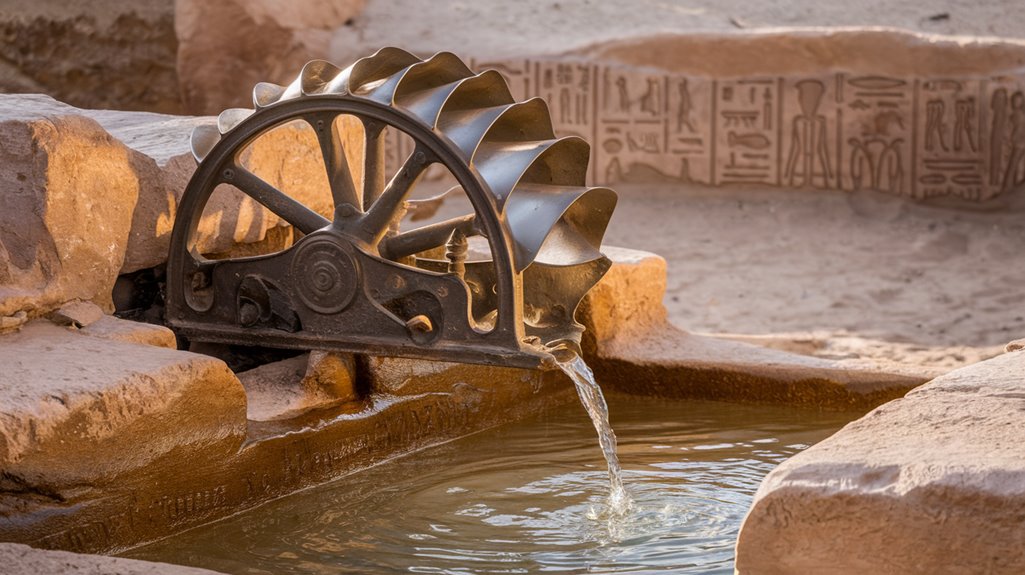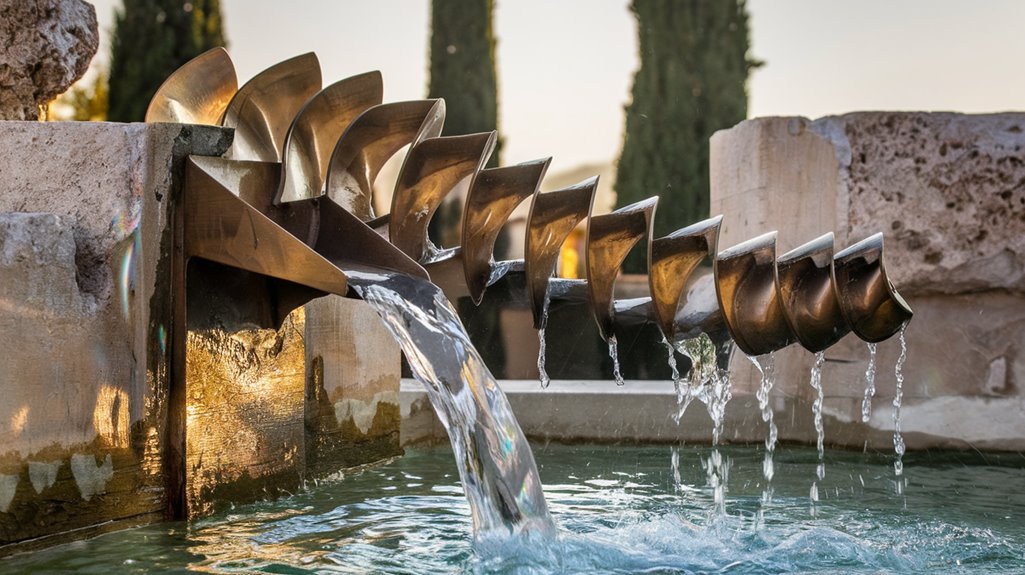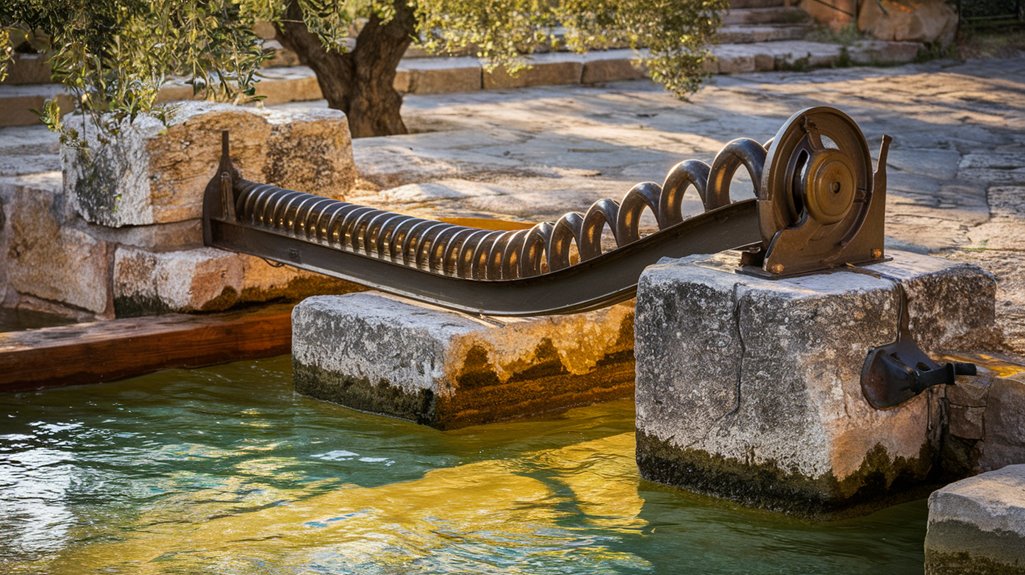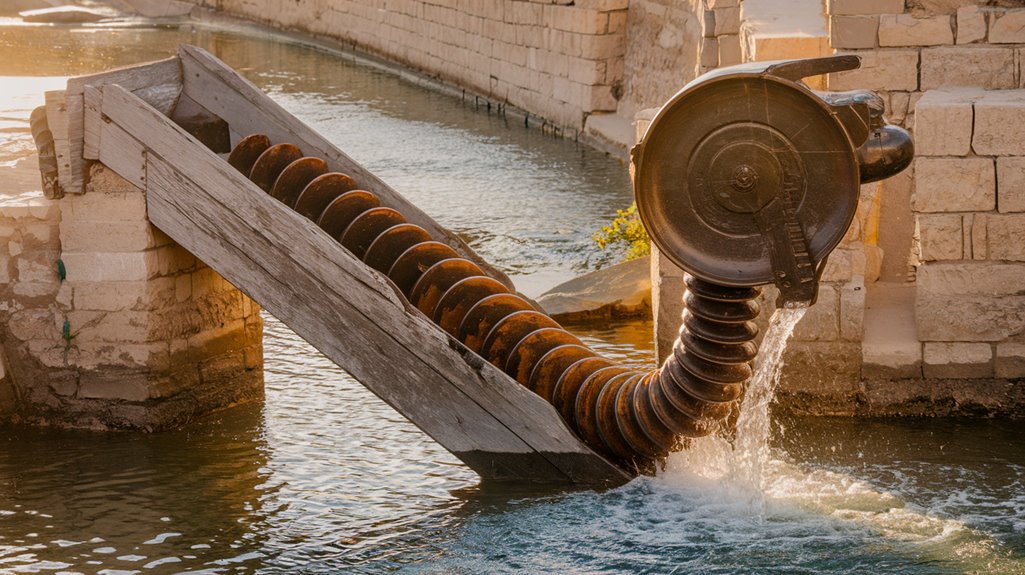The Archimedes Screw: 2,000-Year-Old Water-Lifting Wonder
You've probably seen water moving uphill and wondered how that's possible. The Archimedes Screw, a marvel of ancient engineering, has been making this seemingly impossible feat a reality for over two millennia. While its origins trace back to Egypt's Nile Delta, this deceptively simple invention hasn't just survived—it's thrived. From powering modern hydroelectric plants to revolutionizing waste management, this ancient device holds secrets that continue to shape our world.
Ancient Origins and Historical Development

While many attribute the Archimedes screw solely to its namesake, this remarkable water-lifting device actually predates the Greek mathematician by several centuries.
You'll find evidence of its use in ancient civilizations as far back as the 7th century BC, with both Egyptian and Assyrian societies utilizing early versions of this ingenious tool.
The technology's true origins can be traced to the bronze-cast screw pumps of Assyria during King Sennacherib's reign.
When Archimedes visited Egypt around 234 BC, he likely encountered these existing irrigation techniques and improved upon them.
The screw's manual rotation design made it easy to operate by hand or with animal power.
The device proved so effective that it became a cornerstone of agricultural development throughout the Mediterranean region, continuing to shape water management practices for over two millennia. The screw's design allowed it to efficiently raise trapped water between its threads when turned at an angle.
Understanding the Core Design and Mechanics
A marvel of ancient engineering, the Archimedes screw operates through an elegantly simple design that's proven remarkably effective for over two millennia.
You'll find its core structure consists of a helical surface wrapped around a central shaft, all encased within a hollow pipe. While perfect water-tightness isn't necessary, careful material selection enhances performance. This innovative design can generate high torque at low running frequencies. Originally developed in Egypt, the device was used for lifting Nile water to higher elevations for irrigation purposes.
Through modern design optimization, you can achieve efficiency rates up to 92.9% by fine-tuning parameters like the 35° inclination angle and flow rates around 0.015 m³/s.
Whether powered by windmill, animal labor, or modern motors, the screw's adaptable nature remains one of its greatest strengths.
Historical versions used wood strips or bronze sheeting sealed with pitch, but today's models incorporate advanced materials while maintaining the same ingenious mechanical principles.
Operating Principles and Technical Specifications
Mastering the Archimedes screw's operation requires understanding its fundamental lifting mechanism. When you rotate the screw, its helical surface scoops water at the bottom and pushes it upward through a hollow pipe until it pours out at the top. Clear vinyl tubing wrapped in a spiral pattern creates the necessary water-lifting channels.
The screw mechanics are remarkably tolerant of leakage, as subsequent segments continue pushing water upward. Konrad Kyeser's crank improved efficiency by replacing manual treading in 1405.
You'll find impressive hydraulic efficiency in modern designs, with flow rates reaching 250 liters per second for 1-meter screws and up to 14.5 cubic meters per second for 5-meter versions.
The device's performance peaks when you maintain specific ratios: inner radius to outer radius of 0.5, and pitch to double outer radius of 1.
For ideal results, you'll want to set the inclination angle around 24 degrees, though some applications perform better at 35 degrees.
Modern Applications Across Industries
Beyond its technical specifications, the Archimedes screw has found its way into numerous modern industries. You'll find agricultural innovations leveraging this ancient technology for irrigation, combining harvesting, and field drainage.
Industrial efficiencies have been dramatically improved through its application in wastewater treatment and stormwater management. The device's minimal environmental impact makes it particularly valuable for sensitive aquatic ecosystems. A notable example in Concord features three massive screws that transport raw sewage into treatment facilities.
The most exciting recent developments include:
- Hydroelectric power generation using fish-friendly composite screw turbines
- Wastewater treatment facilities utilizing screws for efficient sludge separation
- Modern farming equipment incorporating screws for grain transport
- Innovative water management systems for flood control and irrigation
The versatility of this ancient device continues to surprise engineers and innovators.
From chocolate fountains to snow blowers, you'll discover the Archimedes screw quietly powering many aspects of modern life, proving that some of the best solutions stand the test of time.
Environmental Benefits and Future Possibilities

While traditional water-lifting technologies often strain environmental resources, the Archimedes screw stands out as a remarkably eco-friendly solution.
You'll find this sustainable technology delivers impressive results, with studies showing up to 44% energy savings compared to conventional submersible pumps. Recent installations have demonstrated that compact trough designs require no modifications to existing concrete structures. Research shows that the technology causes no immediate mortality in fish populations passing through the turbine. It's a prime example of eco-friendly innovation that continues to evolve through advanced materials and smart design.
The screw's environmental benefits are substantial: fish-friendly operation due to slow rotation speeds, minimal habitat disruption, and reduced carbon footprint through composite materials.
You can see its versatility in modern applications, from low-head hydropower generation to efficient pumping stations.
With features like variable speed drives and gel-coated blades, today's Archimedes screws offer enhanced performance while maintaining their commitment to environmental preservation.










